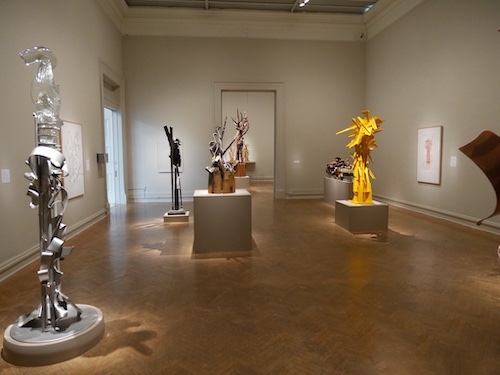
When we were in Washington DC, we were fortunate to see the Corcoran Gallery before it is absorbed into the Smithsonian, and even more fortunate to see a special exhibition of the life progression of the metal sculptor, Albert Paley. Albert Paley, an active artist for close to 50 years at his studio in Rochester, New York, is the first metal sculptor to receive the coveted Institute Honors awarded by the American Institute of Architects, the AIA’s highest award to a non-architect. “The allure of Paley’s art comes through its intrinsic sense of integration of art and architecture,” as one noted architect stated. Paley, Distinguished Professor, holds an Endowed Chair at the College of Imaging Arts and Sciences at Rochester Institute of Technology. What is cool about this exhibition is that it covers all aspects of his career, starting with suitably monumental jewelry and tables to his more recent monumental works. Furthermore, Paley’s creative process is represented throughout the exhibition by drawings, maquettes, and photographs. He continually pushes the boundaries of what is thought to be possible with iron and steel. Moreover, when you examine the pieces in person, the craftsmanship shows a mastery of metal that is almost incomprehensible. We visit a lot of museums and this was really one of the most thought provoking and exciting exhibitions we have been to in a very long while.





Albert Paley became interested in jewelry as a student at the Tyler School of Art in Philadelphia, where he pursued a major in sculpture and a minor in metalwork. In his sculpture classes, he learned to manipulate form and mass. He began making jewelry in his metalwork classes under the direction of Stanley Lechtzin. Lechtzin was an influential force in developing the New Jewelry movement, which departed from traditional postwar jewelry design by giving equal emphasis to quality craftsmanship and formal innovation. Stylistically, Paley’s early jewelry shows Lechtzin’s influence, but he quickly developed his own ornamental vocabulary. In America, New Jewelry designers like Paley were prone to grand sculptural and theatrical statements, playing into a growing desire for spectacle. Turning to different mediums, Paley successfully transferred these qualities to domestic lighting and furniture.



For centuries, iron screens and gates have been used to protect as well as to define the difference between private and public space. In the hands of highly skilled artisans such as Jean Tijou (active 1688-1712), who designed and made the screens at Hampton Court Palace in England or Jean Lamour (1698-1771), responsible for those that surround the Place Stanislas in Nancy, France, these works exhibit rich ornamental schemes to emphasize a client’s taste and wealth. Albert Paley’s design and execution of the Renwick Gallery’s Portal Gates, 1974, and New York State Senate Chamber’s Portal Gates, 1980, demonstrated that he could work on a larger decorative and architectural scale than he had done previously. These commissions also showed his transformation of a richly ornate and embellished vocabulary to a contemporary idiom.







“Animals Always” is a civic archway at the southeast entrance to the Saint Louis Zoological Park. It is 130 feet long and 36 feet high—the equivalent of the combined height of two giraffes-and made from 100 tons of COR-TEN steel. Working closely with zoo staff to represent the fauna in their charge, Paley’s ornate compositionincorporates over 60 animals in a sculptural habitat of trees, ferns,and other plant life. The commission took three years to develop, design and fabricate. It was completed in 2006.Paley’s monumental gateway to the zoo was an extension and elaboration of two earlier projects. The first was a proposal for a similar but never completed entrance to the Central Park Zoo in New York in 1985, which was his first venture into figurative and animal imagery. The second project was the Kohl Gate at the main entrance to the Cleveland Botanical Gardens, which was completed and unveiled in May 2004. At 60 feet long and 15 feet high, it too is constructed from COR-TEN steel, and is similarly elaborated with motifs that mirror the Botanical Gardens’ own diverse collection of plants native to Costa Rica, Madagascar, and Ohio.







Perhaps the most interesting part of the exhibition were the maquettes (scale models) of giant steel installations. For instance, the Clay Center Sculpture is 70 feet tall, the Evanesce Sculpture is 200 feet tall and The Promise is 40 feet tall. These site specific sculptures enhance the spare modernistic surroundings and bring artistic life to the areas they are installed. If you visit a city with one of his sculptures, enjoy. Unfortunately, the Corcoran’s college, buildings, and collection will be divided up between the National Gallery of Art and George Washington University and the Corcoran is now closed. The collection of art, worth an estimated $2 billion, will go to the National Museum.
[mappress mapid=”62″]
References:
Albert Paley Studios: http://www.albertpaley.com/
Corcoran Galleries: http://www.corcoran.org/
Dissolution of the Corcoran Gallery: http://www.washingtoncitypaper.com/blogs/artsdesk/visual-arts/2014/08/21/the-corcoran-gallery-is-free-starting-friday/
GW University: http://corcoran.gwu.edu/

